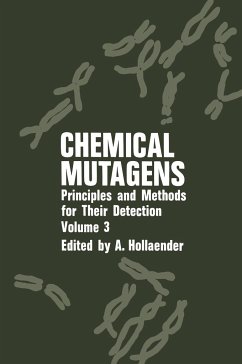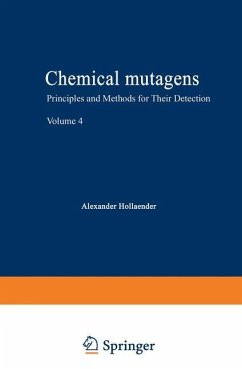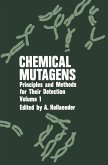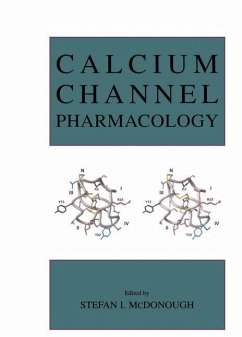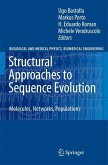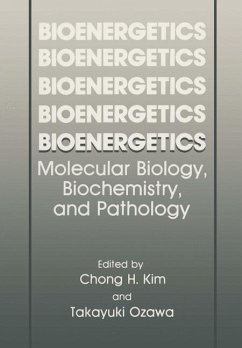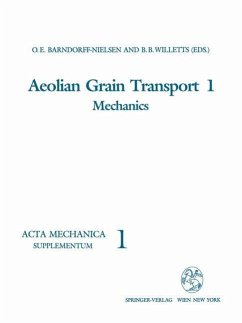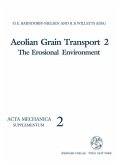- Broschiertes Buch
- Merkliste
- Auf die Merkliste
- Bewerten Bewerten
- Teilen
- Produkt teilen
- Produkterinnerung
- Produkterinnerung
The ready acceptance and wide demand for copies of the first two volumes of Chemical Mutagens: Principles and Methods Jar Their Detection have demon strated the need for wider dissemination of information on this timely and urgent subject. Therefore, it was imperative that a third volume be prepared to include more detailed discussions on techniques of some of the methods that were presented from a theoretical point of view in the first two volumes, and to update this rapidly expanding field with current findings and the new developments that have taken place in the past three years. Also…mehr
Andere Kunden interessierten sich auch für
![Chemical Mutagens Chemical Mutagens]() Alexander HollaenderChemical Mutagens39,99 €
Alexander HollaenderChemical Mutagens39,99 €![Chemical Mutagens Chemical Mutagens]() Alexander HollaenderChemical Mutagens39,99 €
Alexander HollaenderChemical Mutagens39,99 €![Calcium Channel Pharmacology Calcium Channel Pharmacology]() Calcium Channel Pharmacology112,99 €
Calcium Channel Pharmacology112,99 €![Structural Approaches to Sequence Evolution Structural Approaches to Sequence Evolution]() Ugo Bastolla / Markus Porto / H. Eduardo Roman / Michele Vendruscolo (eds.)Structural Approaches to Sequence Evolution75,99 €
Ugo Bastolla / Markus Porto / H. Eduardo Roman / Michele Vendruscolo (eds.)Structural Approaches to Sequence Evolution75,99 €![Bioenergetics Bioenergetics]() Chong H. KimBioenergetics38,99 €
Chong H. KimBioenergetics38,99 €![Aeolian Grain Transport 1 Aeolian Grain Transport 1]() Ole E. Barndorff-Nielsen / Brian B. Willetts (eds.)Aeolian Grain Transport 139,99 €
Ole E. Barndorff-Nielsen / Brian B. Willetts (eds.)Aeolian Grain Transport 139,99 €![Aeolian Grain Transport Aeolian Grain Transport]() Barndorff-NielsenAeolian Grain Transport39,99 €
Barndorff-NielsenAeolian Grain Transport39,99 €-
-
-
The ready acceptance and wide demand for copies of the first two volumes of Chemical Mutagens: Principles and Methods Jar Their Detection have demon strated the need for wider dissemination of information on this timely and urgent subject. Therefore, it was imperative that a third volume be prepared to include more detailed discussions on techniques of some of the methods that were presented from a theoretical point of view in the first two volumes, and to update this rapidly expanding field with current findings and the new developments that have taken place in the past three years. Also included is a special chapter by Dr. Charlotte Auerbach giving the historical background of the discovery of chemical mutagenesis. Methods for recognizing mutagenic compounds in vitro are a necessary preliminary step toward arriving at satisfactory solutions for recognizing significant mutation rates in man, which must be done before our test tube methods of detection can be considered reliable.Two chapters in this volume make important contributions to this problem. Due to the increasing activity in efforts to perfect techniques for detecting chemical mutagens and their effects on man, it is planned to continue this series of volumes as necessary to keep abreast of current findings.
Hinweis: Dieser Artikel kann nur an eine deutsche Lieferadresse ausgeliefert werden.
Hinweis: Dieser Artikel kann nur an eine deutsche Lieferadresse ausgeliefert werden.
Produktdetails
- Produktdetails
- Verlag: Springer / Springer US / Springer, Berlin
- Artikelnr. des Verlages: 978-1-4615-8974-7
- 1973
- Seitenzahl: 332
- Erscheinungstermin: 5. Februar 2012
- Englisch
- Abmessung: 229mm x 152mm x 19mm
- Gewicht: 482g
- ISBN-13: 9781461589747
- ISBN-10: 1461589746
- Artikelnr.: 41321371
- Herstellerkennzeichnung
- Springer-Verlag GmbH
- Tiergartenstr. 17
- 69121 Heidelberg
- ProductSafety@springernature.com
- Verlag: Springer / Springer US / Springer, Berlin
- Artikelnr. des Verlages: 978-1-4615-8974-7
- 1973
- Seitenzahl: 332
- Erscheinungstermin: 5. Februar 2012
- Englisch
- Abmessung: 229mm x 152mm x 19mm
- Gewicht: 482g
- ISBN-13: 9781461589747
- ISBN-10: 1461589746
- Artikelnr.: 41321371
- Herstellerkennzeichnung
- Springer-Verlag GmbH
- Tiergartenstr. 17
- 69121 Heidelberg
- ProductSafety@springernature.com
of Volume 3.- 24 History of Research on Chemical Mutagenesis.- I. Introduction.- II. War Gases.- III. Other Alkylating Agents.- IV. Nitroso Compounds.- V. Urethane.- VI. Alkaloids.- VII. Inorganic Salts.- VIII. Formaldehyde, Organic Peroxides.- IX. Nitrous Acid.- X. Calf Thymus DNA and Other Macromolecules, Carcinogens.- XI Phenols.- XII. Basic Dyes.- XIII. Purines.- XIV. Base Analogues.- XV. Epilogue.- XVI. References.- 25 Observations on Meiotic Chromosomes of the Male Mouse as a Test of the Potential Mutagenicity of Chemicals in Mammals.- I. Introduction.- II. Methods for Detecting Chromosome Aberrations.- III. Experimental Results with Ionizing Radiation.- IV. Experimental Results with Chemical Mutagens.- V. Acknowledgments.- VI. References.- 26 Techniques for Monitoring and Assessing the Significance of Mutagenesis in Human Populations.- I. Introduction.- II. Kinds of Information about Human Populations Needed for Monitoring.- III. Limitations and Advantages of Using Existing Population Records.- IV. Information Content of the Available Records.- V. Methods of Record Linkage.- VI. Relevant Data Obtained by Record Linkage.- VII. Future Accessibility of Diagnostic Data.- VIII. Mutagenesis and the Search for an Optimum Environment for Man.- IX. Conclusions for Geneticists.- X. References.- 27 Specific-Locus Mutational Assay Systems for Mouse Lymphoma Cells.- I. Introduction.- II. HGPRT Locus.- III. TK Locus: General Principles.- IV. TK Locus in a Mutational Assay System.- V. Concluding Remarks.- VI. Acknowledgments.- VII. References.- 28 Approaches to Monitoring Human Populations for Mutation Rates and Genetic Disease.- I. Introduction.- II. Theoretical Importance of Measurements in Man.- III. Practical Importance of Human Genetic Monitoring.- IV. Study of Mutation atthe Molecular Level.- V. Critique of Genetic Monitoring Based on Electrophoresis.- VI. Does the Initial Approach Meet the Criteria for a Satisfactory Monitoring System?.- VII. Estimates of the Magnitude of Effort Required.- VIII. Importance of Accurate Information.- IX. Some Technological Requirements.- X. Assessment of Technological Possibilities (Using Electrophoresis).- XI. Methods Based on Activity Measurements.- XII. Low Molecular Weight Substances.- XIII. Confirmatory Analyses, Genetic Follow-up, and Data Reduction.- XIV. Genetic Monitoring as a National Problem.- XV. Conclusions.- XVI. References.- 29 Repair of Chemical Damage to Human DNA.- I. Introduction.- II. Sequence of Molecular Events in Experiments with Mutagenic and Carcinogenic Agents.- III. What Can DNA Repair Studies Tell Us?.- IV. Methods of Studying Repair.- V. The Two Forms of Repair as Measured by BrUra Photolysis.- VI. Classification of DNA-Damaging Chemical Agents According to the Repair Sequence Induced.- VII. Xeroderma Pigmentosum and UV-Type Repair after Chemical Damage to DNA.- VIII. Summary of Present Interpretations.- IX. Acknowledgments.- X. References.- 30 Tradescantia Stamen Hairs: A Radiobiological Test System Applicable to Chemical Mutagenesis.- I. Introduction.- II. Techniques and Procedures.- III. Characteristic Data Obtained from the Stamen-Hair System.- IV. Summary.- V. Acknowledgments.- VI. References.- 31 Detection of Genetically Active Chemicals Using Various Yeast Systems.- I. Brief Description of the Yeasts Used in Genetic Research.- II. Techniques.- III. Treatment Conditions.- IV. Systems Used to Detect Mutagenicity of Chemicals.- V. Evaluation of Mutagenesis Experiments and Complications.- VI. The Problem of Metabolic Activation.- VII. Mitotic Recombination.- VIII. MethodsUsed to Increase Sensitivity to Genetically Active Agents.- IX. General Evaluation.- X. Acknowledgments.- XI. References.- 32 Total Reproductive Capacity in Female Mice: Chemical Effects and Their Analysis.- I. Introduction.- II. Oocyte Development and Responses to Radiation Effects.- III. General Procedure.- IV. Fertility Effects of Alkylating Chemicals on Female Mice.- V. Delayed Pathological and Survival Effects in Chemically Treated Female Mice in the Total Reproductive Capacity Experiment.- VI. Importance of Using Females in Fertility Studies.- VII. Need for Assay Systems in Female Mice to Measure Induced Heritable Genetic Damage.- VIII. References.- 33 Insect Chemosterilants as Mutagens.- I. Introduction.- II. Screening of Chemosterilants.- III. Classification of Chemosterilants.- IV. Conclusion.- V. References.- 34 The Literature of Chemical Mutagenesis.- I. Introduction.- II. The State of Chemical Mutagenesis Literature.- III. Sources and Types of Chemical Mutagenesis Literature.- IV. Organization of Chemical Mutagenesis Information.- V. Some Suggestions for Improving Literature Control.- VI. Conclusion.- VII: Acknowledgments.- Author Index.
of Volume 3.- 24 History of Research on Chemical Mutagenesis.- I. Introduction.- II. War Gases.- III. Other Alkylating Agents.- IV. Nitroso Compounds.- V. Urethane.- VI. Alkaloids.- VII. Inorganic Salts.- VIII. Formaldehyde, Organic Peroxides.- IX. Nitrous Acid.- X. Calf Thymus DNA and Other Macromolecules, Carcinogens.- XI Phenols.- XII. Basic Dyes.- XIII. Purines.- XIV. Base Analogues.- XV. Epilogue.- XVI. References.- 25 Observations on Meiotic Chromosomes of the Male Mouse as a Test of the Potential Mutagenicity of Chemicals in Mammals.- I. Introduction.- II. Methods for Detecting Chromosome Aberrations.- III. Experimental Results with Ionizing Radiation.- IV. Experimental Results with Chemical Mutagens.- V. Acknowledgments.- VI. References.- 26 Techniques for Monitoring and Assessing the Significance of Mutagenesis in Human Populations.- I. Introduction.- II. Kinds of Information about Human Populations Needed for Monitoring.- III. Limitations and Advantages of Using Existing Population Records.- IV. Information Content of the Available Records.- V. Methods of Record Linkage.- VI. Relevant Data Obtained by Record Linkage.- VII. Future Accessibility of Diagnostic Data.- VIII. Mutagenesis and the Search for an Optimum Environment for Man.- IX. Conclusions for Geneticists.- X. References.- 27 Specific-Locus Mutational Assay Systems for Mouse Lymphoma Cells.- I. Introduction.- II. HGPRT Locus.- III. TK Locus: General Principles.- IV. TK Locus in a Mutational Assay System.- V. Concluding Remarks.- VI. Acknowledgments.- VII. References.- 28 Approaches to Monitoring Human Populations for Mutation Rates and Genetic Disease.- I. Introduction.- II. Theoretical Importance of Measurements in Man.- III. Practical Importance of Human Genetic Monitoring.- IV. Study of Mutation atthe Molecular Level.- V. Critique of Genetic Monitoring Based on Electrophoresis.- VI. Does the Initial Approach Meet the Criteria for a Satisfactory Monitoring System?.- VII. Estimates of the Magnitude of Effort Required.- VIII. Importance of Accurate Information.- IX. Some Technological Requirements.- X. Assessment of Technological Possibilities (Using Electrophoresis).- XI. Methods Based on Activity Measurements.- XII. Low Molecular Weight Substances.- XIII. Confirmatory Analyses, Genetic Follow-up, and Data Reduction.- XIV. Genetic Monitoring as a National Problem.- XV. Conclusions.- XVI. References.- 29 Repair of Chemical Damage to Human DNA.- I. Introduction.- II. Sequence of Molecular Events in Experiments with Mutagenic and Carcinogenic Agents.- III. What Can DNA Repair Studies Tell Us?.- IV. Methods of Studying Repair.- V. The Two Forms of Repair as Measured by BrUra Photolysis.- VI. Classification of DNA-Damaging Chemical Agents According to the Repair Sequence Induced.- VII. Xeroderma Pigmentosum and UV-Type Repair after Chemical Damage to DNA.- VIII. Summary of Present Interpretations.- IX. Acknowledgments.- X. References.- 30 Tradescantia Stamen Hairs: A Radiobiological Test System Applicable to Chemical Mutagenesis.- I. Introduction.- II. Techniques and Procedures.- III. Characteristic Data Obtained from the Stamen-Hair System.- IV. Summary.- V. Acknowledgments.- VI. References.- 31 Detection of Genetically Active Chemicals Using Various Yeast Systems.- I. Brief Description of the Yeasts Used in Genetic Research.- II. Techniques.- III. Treatment Conditions.- IV. Systems Used to Detect Mutagenicity of Chemicals.- V. Evaluation of Mutagenesis Experiments and Complications.- VI. The Problem of Metabolic Activation.- VII. Mitotic Recombination.- VIII. MethodsUsed to Increase Sensitivity to Genetically Active Agents.- IX. General Evaluation.- X. Acknowledgments.- XI. References.- 32 Total Reproductive Capacity in Female Mice: Chemical Effects and Their Analysis.- I. Introduction.- II. Oocyte Development and Responses to Radiation Effects.- III. General Procedure.- IV. Fertility Effects of Alkylating Chemicals on Female Mice.- V. Delayed Pathological and Survival Effects in Chemically Treated Female Mice in the Total Reproductive Capacity Experiment.- VI. Importance of Using Females in Fertility Studies.- VII. Need for Assay Systems in Female Mice to Measure Induced Heritable Genetic Damage.- VIII. References.- 33 Insect Chemosterilants as Mutagens.- I. Introduction.- II. Screening of Chemosterilants.- III. Classification of Chemosterilants.- IV. Conclusion.- V. References.- 34 The Literature of Chemical Mutagenesis.- I. Introduction.- II. The State of Chemical Mutagenesis Literature.- III. Sources and Types of Chemical Mutagenesis Literature.- IV. Organization of Chemical Mutagenesis Information.- V. Some Suggestions for Improving Literature Control.- VI. Conclusion.- VII: Acknowledgments.- Author Index.

